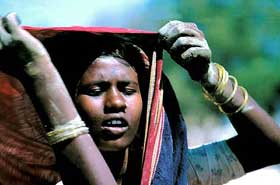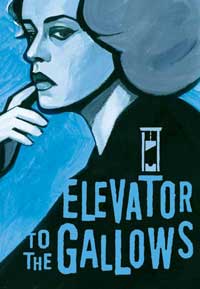Jeanne Moreau as Florence Carala is at the height of her sensual stunning beauty in the sharp-focus harsh-contrast b/w film noir Elevator to the Gallows (Ascenseur pour l'Echafaud, 1958).
She is frequently without make-up, so is seen for once as a natural & quite timeless vision, though when first released, critics accustomed to "fashionable" gobs of facial goo criticized her look, the fools.
 Julien Tavernier (Maurice Ronet) is scarcely less sensual as a man dangerously in love. These two leads don't actually have to be together in the context of the film for their relationship to sparks fire at a distance. Julien Tavernier (Maurice Ronet) is scarcely less sensual as a man dangerously in love. These two leads don't actually have to be together in the context of the film for their relationship to sparks fire at a distance.
Florence & Julien have a plan that'll guarantee they'll always be together. He kills his war-profiteering boss Simon Carala (Jean Wall), making it look like suicide, setting it up as a "locked room mystery" should anyone suppose it was murder.
The plan seems to be going pretty nicely. But the security guard in the office building, not knowing Julien is in the elevator, shuts off the electricity & locks up the building. Julien's trapped in the elevator at the scene of his crime!
Florence is waiting to meet him nearby. He cannot make the rendezvous given his position, but Florence sees his car speed by with another woman in the passenger seat, a flowergirl (Yori Bertin) who works in the florist shop across from her husband's office tower.
Not seeing the driver, & never imagining the car might've been stolen, she thinks Julien lost his nerve & has abandoned her for another, younger woman.
There's a certain beatnik style especially to the scenes with the young couple Veronique & Louis (Georges Poujouly), who have taken Julien's car. They also have his gun. They check into a motel under his name, as "Mr. & Mrs. Tavernier," so we just know the identity mix-up will lead to maximum trouble.
 Meanwhile Julien's harrowing experiences attempting to get out of the elevator are intense. Forlorn Florence wanders the neighborhood checking clubs, looking for her errant lover. Meanwhile Julien's harrowing experiences attempting to get out of the elevator are intense. Forlorn Florence wanders the neighborhood checking clubs, looking for her errant lover.
The thieving delinquent murders two German tourists & leaves behind Julien's car & gun. By the time Julien Tavernier gets out of the elevator, he's already wanted for a completely different murder than the one of which he's guilty.
Julien succeeds in never being detected in the elevator, but upon his escape, he too soon discovers he needs to prove where he was at the time of a double murder. His car, gun, & jacket all provide evidence that he killed the German tourists.
A lovers' suicide pact, between the young couple, adds further complications. When Veronique & her boyfriend wake up from their ridiculous suicide attempt many hours later, they see the morning paper's report of the double murder. They realize they might after all get away with their crime, but only if they can find & destroy a certain piece of evidence. Florence is also after the same evidence to clear her lover.
Throughout, we are treated to one of the most stupendous film noir soundtracks of all time -- by Miles Davis. The look & the sound of the film comes across so artfully advanced, it's hard to understand how Louis Malle could've gotten everything this perfect in his very first feature film. He was already a confirmed master!
Eventually the police will turn out to have been a lot less stupid than just about everyone was hoping they would be, & it will be Miles Davis who sounds that final note of justice & high angst.
 I wanted to discuss Louis Malle's epic documentary Phantom India (L'Indie Fantome, 1968) following a film of his that deserves the highest praise, lest it seem as if I seriously dislike his work. I wanted to discuss Louis Malle's epic documentary Phantom India (L'Indie Fantome, 1968) following a film of his that deserves the highest praise, lest it seem as if I seriously dislike his work.
I love some of his films unreservedly, but Phantom India just bored the living crap out of me. In seven parts, I watched it in a small arthouse cinema two nights in a row, & it was a real struggle to get my aching ass to the theater for the second night.
Had I been home with a dvd I would never have made it through. But having voluntarily become part of a captive audience, I persevered. In that much footage some good stuff is bound to pop up, but overall, it's crammed with dithering "observations" which, though not overtly racist, are certainly ignorant of the subject filmed. Louis Malle seems to delight in knowing nothing about what he films but offering his unlearned opinon even so.
His camera's eye does a better job of capturing revealing moments of foreigners in India than in documenting India itself, as this set of documentaries is in great part really about Louis Malle & by extension others like himself, outsiders, all of whom he at least seems to realize are dorks.
The documentary is nevertheless legendary, the more so I think because for decades it has remained almost impossible to see it in its entirety. It's easy to imagine it is great work sight unseen. That critics who've actually watched it & have thought it tremendous make me wonder if they hadn't nodded off & dreamt something better.
 There is often too much camera motion as though Malle thought he was shooting an action picture or chasing wildlife on a savannah. He captures "the teeming masses" like a nature photographer who has encountered a pond thick with tadpoles, or a sky blackened with a humongous flock of birds. There is often too much camera motion as though Malle thought he was shooting an action picture or chasing wildlife on a savannah. He captures "the teeming masses" like a nature photographer who has encountered a pond thick with tadpoles, or a sky blackened with a humongous flock of birds.
He shows Indian women with a casual objectification like a school boy whacking off to National Geographic nudes. He seems to think rituals & festivals & the people of India are as alien as anything imagined of Barsoom.
Having done little or no research about India, Louis's self-absorbed narration is much more a sociological document about the assumptions, misunderstandings, condescensions, & easy romanticism born not of the world he's photographing, but of privileged upper class Paris.
The star of the film, like any wealthy tourist's home movie, is not the subject shown, but the filmmaker, for in his desire to prove Indians are inscrutably oriental rather than perfectly human, we learn more of French romanticism than of a vital nation.
 If it were possible to select a voice-over track & turn that off, the images might become a worthwile document of a specific point in history, India of 1967. But this might well be said of any unlearned tourist's footage. If it were possible to select a voice-over track & turn that off, the images might become a worthwile document of a specific point in history, India of 1967. But this might well be said of any unlearned tourist's footage.
Louis intentially made the film seem a little bit rough, adopting a rather excitable tone, as he wanted to present something immediate & visceral rather than knowledgeable & professionally edited. In his lifetime he always spoke highly of the project & its result, & many film fans & film historians seem to agree, though I surely do not.
The seven episodes are individually titled: 1) The Impossible Camera. 2) Things Seen in Madras. 3) The Indians & the Sacred. 4) Dreams & Reality. 5) A Look at Castes. 6) On the Fringes of Indian Society. 7) Bombay.
There is additionally a pictorial documentary by Louis Malle called Calcutta (1969) for which he does not intrude himself to excess.
There also exists a 90-minute BBC condensation of the original six-plus-hours, called Louis Malle's India: A Film Journey (1995), which had a limited dvd issue difficult to track down. I've never seen it, but it's easy to imagine 90 minutes of good stuff found amidst the meandering whole.
Ordinarily I wouldn't recommend the Reader's Digest version of anything. But it might be worth checking out the condensed version, if it comes available, before committing to ten tedious hours. If you can't stand it in shortened form, it's not going to be improved by watching it all week.
copyright © by Paghat the Ratgirl
|

 Julien Tavernier (Maurice Ronet) is scarcely less sensual as a man dangerously in love. These two leads don't actually have to be together in the context of the film for their relationship to sparks fire at a distance.
Julien Tavernier (Maurice Ronet) is scarcely less sensual as a man dangerously in love. These two leads don't actually have to be together in the context of the film for their relationship to sparks fire at a distance. Meanwhile Julien's harrowing experiences attempting to get out of the elevator are intense. Forlorn Florence wanders the neighborhood checking clubs, looking for her errant lover.
Meanwhile Julien's harrowing experiences attempting to get out of the elevator are intense. Forlorn Florence wanders the neighborhood checking clubs, looking for her errant lover.
 There is often too much camera motion as though Malle thought he was shooting an action picture or chasing wildlife on a savannah. He captures "the teeming masses" like a nature photographer who has encountered a pond thick with tadpoles, or a sky blackened with a humongous flock of birds.
There is often too much camera motion as though Malle thought he was shooting an action picture or chasing wildlife on a savannah. He captures "the teeming masses" like a nature photographer who has encountered a pond thick with tadpoles, or a sky blackened with a humongous flock of birds. If it were possible to select a voice-over track & turn that off, the images might become a worthwile document of a specific point in history, India of 1967. But this might well be said of any unlearned tourist's footage.
If it were possible to select a voice-over track & turn that off, the images might become a worthwile document of a specific point in history, India of 1967. But this might well be said of any unlearned tourist's footage.